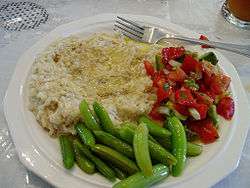Harees
{{Infobox food | name = Harees | image = Al fanar harees (7797136886).jpg | caption = | alternate_name = Jareesh, Hareesa, Arizah | country = [[United Arab Emirates] | region =Middle East | creator = | course = | type = Porridge | served = | main_ingredient = Wheat, butter, and meat (usually mutton) | variations = | calories = | other = }} Harees, Jareesh (Arabic: هريس), boko boko, or harisa (Armenian: հարիսա, romanized: harisa) is a dish of boiled, cracked, or coarsely-ground wheat, mixed with meat and seasoned.[1] Its consistency varies between a porridge and a dumpling. Harees is a popular dish known in Arab states of the Persian Gulf, especially in the month of Ramadan, while harisa is an Armenian dish from the Ararat plain.
Etymology
Harees (Arabic: هريس) is derived from the verb (Arabic: هَرَسَ, romanized: Harasa) which means to mash or to squash.[2]
According to Armenian lore, the patron saint of Armenia, Gregory the Illuminator, was offering a meal of love and charity to the poor. There weren't enough sheep to feed the crowds so wheat was added to the cooking pots. They noticed that the wheat was sticking to the bottom of the cauldrons. Saint Gregory advised, "Harekh! Stir it!" Thus, the name of the dish, harissa, came from the saint's own words. Harissa has been offered as a charity meal ever since.[3] The dish is traditionally served on Easter day. It is still prepared by many Armenians around the world and is also considered the national dish of Armenia.
History
Harees is documented in Ibn Sayyar al-Warraq's 10th-century cookbook Kitab Al Tabikh.,[4] as well as in al-Baghdadi's 13th-century cookbook Kitab Al Tabikh and ibn Razin al-Tujibi's 13th-century Andalusian cookbook Kitab Fadalat al-khiwan fi tayyibat al-ta'am w'al-alwan.
Preparation
The wheat is soaked overnight, then simmered in water along with meat and butter or sheep tail fat. Any remaining liquid is strained and the mixture is beaten and seasoned. Harees may be garnished with cinnamon, sugar, and clarified butter.
Variants and traditions
There is a different traditional way of preparing Harees in each of the Arab countries in the Persian Gulf area, and among the tribes of these countries. But there is a difference very simple that is optional in some countries. For example, in Saudi Arabia, cardamom pods (Hill or Cardamom) are added. Also it is decorated with parsley.
Harees was only made by the wealthy during Ramadan and Eid, for the duration of a three- to seven-day wedding. It was, however, customary for the Harees dishes to be shared with poorer neighbours on such occasions.
It is similar to kashkeg, a kind of homogeneous porridge made of previously stewed and boned chicken or lamb and coarsely ground soaked wheat (typically shelled wheat).
Arab cuisine
Harees is a popular dish in Arab cuisine, from the Levant to the Persian Gulf. It is often served during Ramadan, festivals such as Eid ul-Fitr, and at weddings.[6] In Lebanese villages, it is often cooked on religious occasions in a communal pot. Harise is also a common dish in Iraqi cuisine.
Formerly found only in homes, it is now served in restaurants as well.
Armenian cuisine

Harisa (Armenian: հարիսա, romanized: harisa) is traditionally served on Easter day, and is considered the national dish of Armenia. It is a thick porridge made from korkot (dried or roasted cracked wheat) and fat-rich meat, usually chicken or lamb. Herbs were substituted for meat in harissa when Armenian religious days required fasting and penance. The extremely long cooking process is an essential part of the harissa tradition. Like other ritual dishes, the time taken for preparation is part of its cherished value.[3]
Harisa is known for helping the Armenians of Musa Ler (in Turkey) to survive during the resistance of 1915.[7]
Kashmiri cuisine
Harisa (or hareesa) is very famous in Kashmir Valley and it is prepared during winter,[8] typical made from mutton & rice flour and eaten with Kashmiri Bread called Girda. Kashmiri also made this dish very popular in Punjab.
Zanzibari
In Zanzibar, the dish is called boko boko and may be cooked with lamb, beef, or chicken.[9]
See also
References
- "Al Harees, traditional Emirati Cuisine". UAE Style Magazine. 26 July 2013.
- Team, Almaany. "Definition and meaning of Harees in Arabic - Arabic dictionary - Page 1". www.almaany.com.
- Irina Petrosian, David Underwood (2006). Armenian food: fact, fiction & folklore (2. ed.). Bloomington, Ind.: Yerkir Pub. p. 65. ISBN 9781411698659.
- Charles Perry, "Cooking with the Caliphs", Saudi Aramco World 57:4 (July/August 2006) full text
- "The haleem debate: Why some Indian Muslims are renaming the Ramzan delicacy 'daleem'".
- "Archived copy". Archived from the original on 2010-11-29. Retrieved 2010-11-07.CS1 maint: archived copy as title (link)
- Albala, Ken (2011). Food cultures of the world encyclopedia. Santa Barbara, California: Greenwood. p. 8. ISBN 9780313376276.
- Naqash, Rayan. "It's harissa time again: Savour the traditional winter delicacy that warms up cold Kashmiri mornings". Scroll.in.
- Resta, Lizzie. "A Culture Seen Through Cuisine: Traditional Zanzibari Recipes." (2008). (PDF)